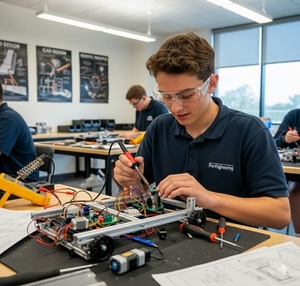Generative artificial intelligence is reshaping the American workforce faster than any previous technological disruption. It is hard to know how AI will disrupt the economy or which jobs it will eventually displace and create, but the conventional wisdom is that repair technicians, welders, and healthcare workers will remain relatively insulated compared to white-collar workers, at least in the near future. In this shifting environment, state leaders have repeatedly highlighted Oklahoma’s career and technical education (CTE) system as key to ensuring that the state’s workforce stays competitive. Yet we haven’t heard enough about what role CTE should play in an AI-driven economy.
If history is any guide, failing to adapt to disruptive innovation can prove costly. Kodak, once the global leader in photography, clung to its film business even as digital imaging took off, an error that ultimately led to its demise. RCA, an icon of the analog music era, made a similar mistake when transistors transformed audio technology. While CTE programs are unlikely to vanish in such dramatic fashion, they do face a similar risk of obsolescence if they cannot adapt their models to the demands of an AI-transformed labor market.
From Technical Training to Human Capability
Artificial intelligence is accelerating a profound shift toward a new kind of labor market that prizes not only technical expertise, but also human qualities machines cannot easily replicate. Employers are increasingly seeking workers who bring soft skills: the constellation of interpersonal, cognitive, and self-management abilities that make people effective collaborators, communicators, and problem-solvers. These skills are also referred to as durable skills, 21st-century skills, social and emotional skills, and non-cognitive skills. Although not all these terms are precisely equivalent, they all refer to sets of skills including resilience, creativity, initiative, ethical judgment, and adaptability that go beyond – or may emerge from – the acquisition of traditional academic competencies.
For CTE to be most effective in the future, it must intentionally teach these competencies alongside technical and academic skills. Employers rate these soft skills as having critical importance, and in some cases, see them as even more valuable than specific technical skills.
Measuring Soft Skills within CTE Systems
A purpose-driven CTE system requires both a focus on clearly defined skills needed in present and future workplaces and methods of measuring success based on outcomes, including both the career and technical skills that are the focus of each program and the soft skills a student needs to succeed in building a career.
To illustrate how these soft skills can be incorporated into CTE, consider the following frameworks. First, the MyWays Student Success Framework identifies 20 interrelated competencies across four domains: Content Knowledge, Creative Know-How, Habits of Success, and Wayfinding Abilities. The model blends academic mastery with creativity, self-management, and the capacity to navigate life transitions. A second example is America Succeeds, which focuses on employer-validated soft skills, including communication, critical thinking, collaboration, adaptability, resilience, and growth mindset.
Together, these frameworks highlight the need for CTE to reorient around transferable, human-centered skills. When CTE aligns MyWays’ broad developmental competencies with America Succeeds’ employer-defined soft skills, it can better prepare students for lifelong adaptability, valuing what learners can do not just what they have studied.
To achieve this alignment, CTE accountability systems must measure outputs and outcomes. Traditional academic metrics such as test scores, graduation rates, and credential attainment remain essential, and a stronger longitudinal data system in Oklahoma might help the state better determine the market value of different academic competencies, as well as new credentials, as neighboring Arkansas and Texas have. However, traditional academic outcomes tell only part of the story. Complementary measures should be developed to include career-readiness indicators, post-CTE placement rates, and assessments of soft skills like teamwork, initiative, and communication.
Innovations in Practice
Across the country, leading CTE programs are already embedding soft skills within hands-on, industry-aligned experiences.
In Georgia, the Advanced Manufacturing High School Apprenticeship Program follows the German apprenticeship model and connects high school students with local manufacturers, technical colleges, and mentors in fields such as CNC machining, welding, and mechatronics. Students earn industry-recognized credentials and college credit while building the collaboration, adaptability, and communication skills that employers prize.
Emerging technologies are enabling new kinds of simulated work that can transform CTE practice. Extended reality (XR)—including virtual and augmented reality can provide realistic simulations that may improve learning outcomes while reducing training costs, especially in health care and advanced manufacturing. Kentucky’s deployment of 2,450 Meta Quest headsets represents the nation’s largest XR-based CTE initiative. As XR and AI become more affordable and accessible, they offer powerful tools for teaching both technical precision and human judgment.
Finally, mastery- and competency-based instructional models can help CTE educators orient learning around students’ goals. By teaching academic content through applied CTE projects and using rigorous, high-quality assessments to evaluate mastery of both technical and soft skills, schools can certify students as career-ready once they demonstrate the competencies needed to thrive in college, work, or further learning.
A Call for Purpose-Driven Transformation
CTE stands at a crossroads. If it continues to rely solely on traditional curricula, it risks being left behind by the pace of technological change. But if CTE leaders align programs with the skills that employers value most (i.e., technical expertise, academic rigor, and soft skills), it can help prepare Oklahoma’s students and workers to be resilient to automation and ready for lifelong growth.
Those who can blend their technical expertise with distinctly human strengths, including creativity, empathy, collaboration, and judgment, will be best equipped to face the coming economic changes. In an AI-driven economy, success is likely to depend on mastering both the tools that power innovation and the soft skills that give that innovation purpose.
Author Bio
Robert Sommers is CEO of Cogniac Consultants, former Oklahoma Secretary of Education, and former Director of the Oklahoma Department of Career and Technology Education.




